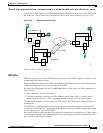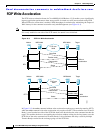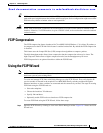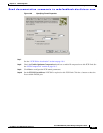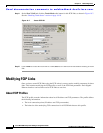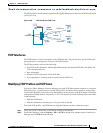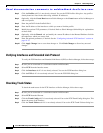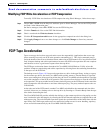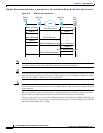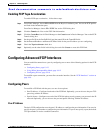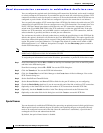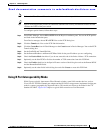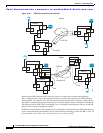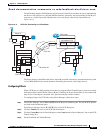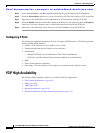
Send documentation comments to mdsfeedback-doc@cisco.com.
19-11
Cisco MDS 9000 Family Fabric Manager Configuration Guide
OL-6965-03, Cisco MDS SAN-OS Release 2.x
Chapter 19 FCIP Configuration
FCIP Tape Acceleration
Modifying FCIP Write Acceleration or FCIP Compression
To modify FCIP Write Acceleration or FCIP compression using Fabric Manager, follow these steps:
Step 1 Choose ISLs > FCIP from the Physical Attributes pane on Fabric Manager. You see the FCIP profiles
and links in the Information pane.
On Device manager, choose IP > FCIP. You see the FCIP dialog box.
Step 2 Click the Tunnels tab. You see the FICP link information.
Step 3 Check or uncheck the WriteAccelerator check box.
Step 4 Click the IP Compression radio button for the appropriate compression ratio in the dialog box.
Step 5 Click Apply Changes icon to save these changes or click Undo Changes to discard any unsaved
changes.
FCIP Tape Acceleration
Tapes are storage devices that store and retrieve user data sequentially. Applications that access tape
drives normally have only one SCSI write operation outstanding to it. This single command process
limits the benefit of the write acceleration feature when using an FCIP tunnel over a long-distance WAN
link. It impacts backup and archive performance because each SCSI write operation does not complete
until the host receives a good status response from the tape drive.
The FCIP tape acceleration feature introduced in Cisco MDS SAN-OS Release 2.0(1b) solves this
problem. It improves tape backup and archive operations by allowing faster data streaming from the host
to the tape over the WAN link.
The backup server in Figure 19-9 issues write operations to a drive in the tape library. Acting as a proxy
for the remote tape drives, the local Cisco MDS switch quickly returns a Transfer Ready to signal the
host to start sending data. After receiving all the data, the local Cisco MDS switch responds to signal the
successful completion of the SCSI write operation. This response allows the host to start the next SCSI
write operation. This proxy method results in more data being sent over the FCIP tunnel in the same time
period compared to the time taken to send data without proxying. The proxy method improves the use
of WAN links.
At the other end of the FCIP tunnel, another Cisco MDS switch buffers the command and data it has
received. It then acts as a backup server to the tape drive by listening to a Transfer Ready from the tape
drive before forwarding the data.
The Cisco MDS SAN-OS provides reliable data delivery to the remote tape drives using tcp/ip over the
wan. it maintains write data integrity by allowing the Write Filemarks operation to complete end-to-end
without proxying. The write filemarks operation signals the synchronization of the buffer data with the
tape library data. While tape media errors are returned to backup servers for error handling, tape busy
errors are retried automatically by the Cisco MDS SAN-OS software.



